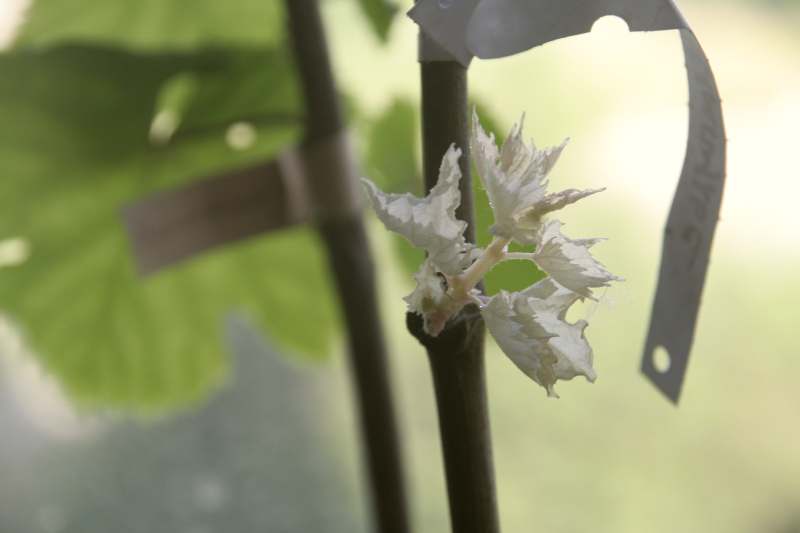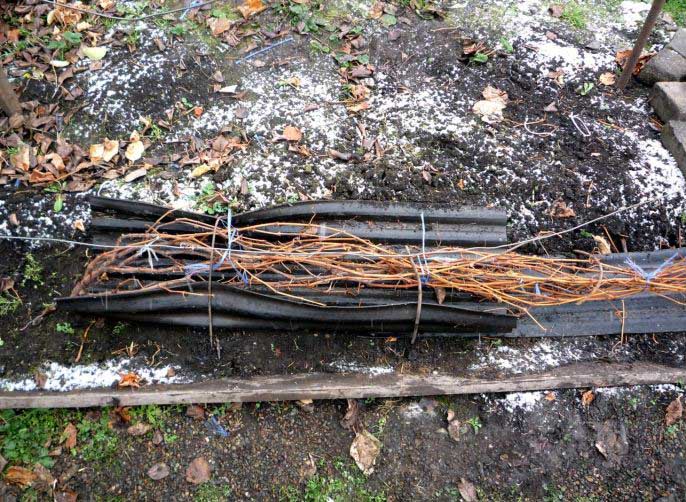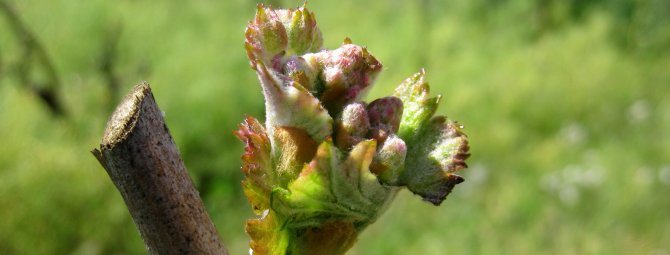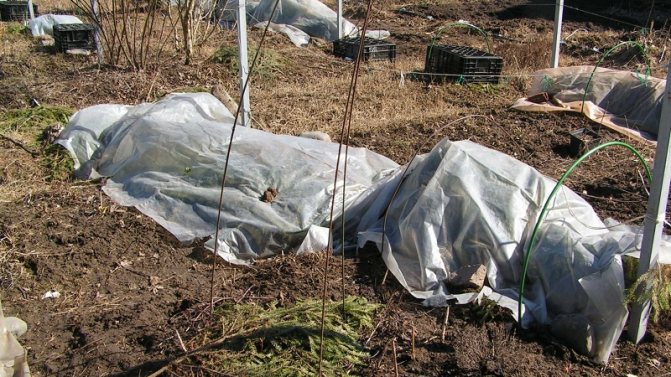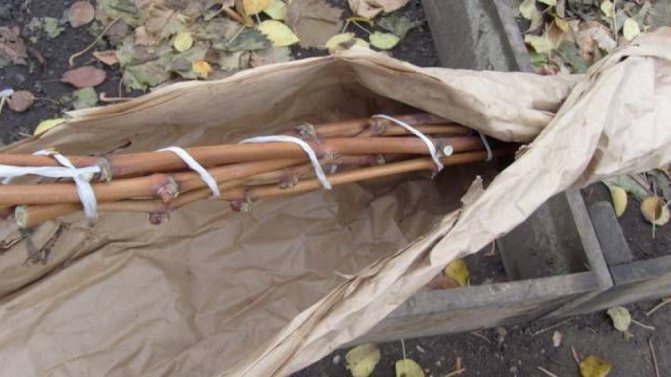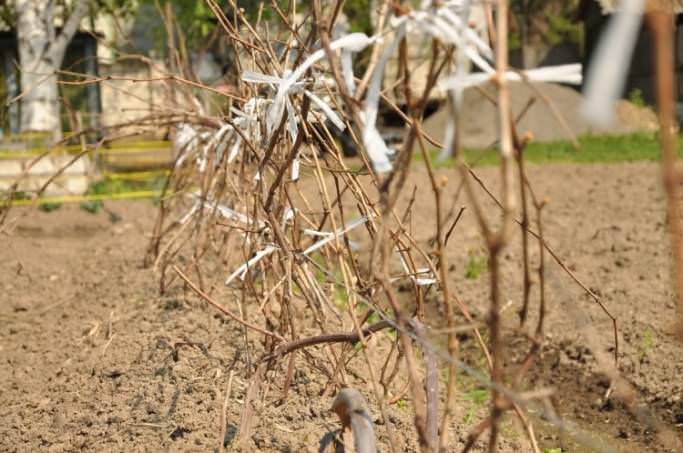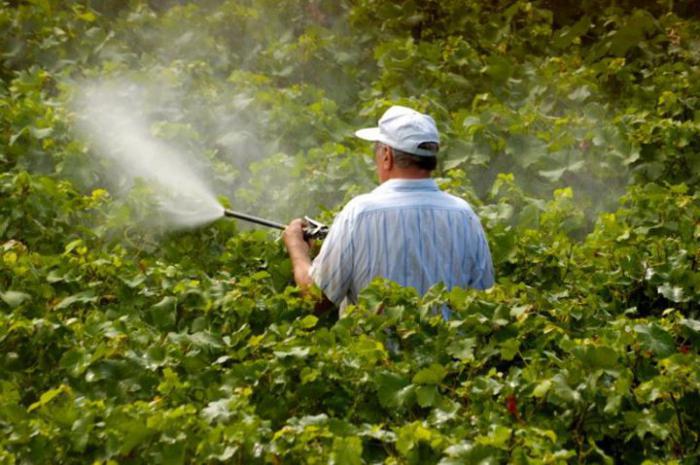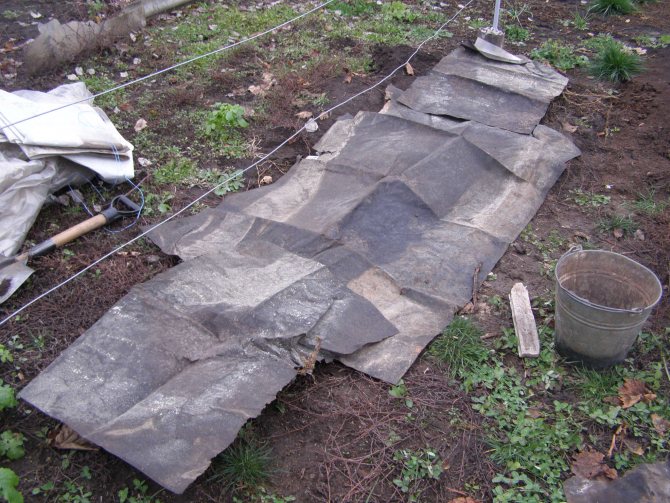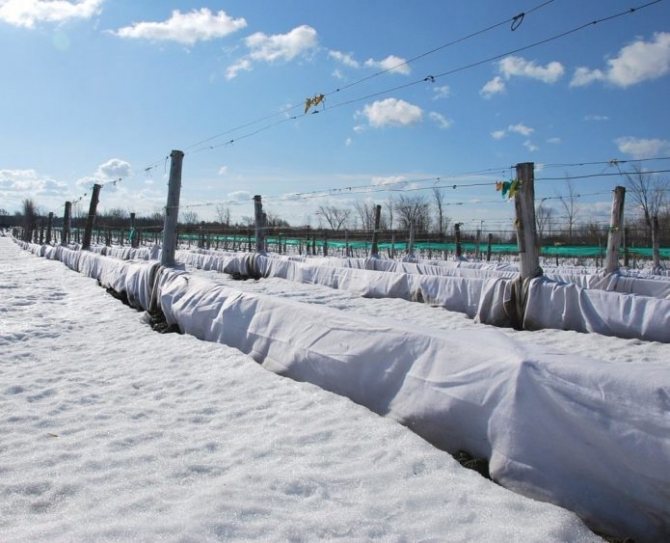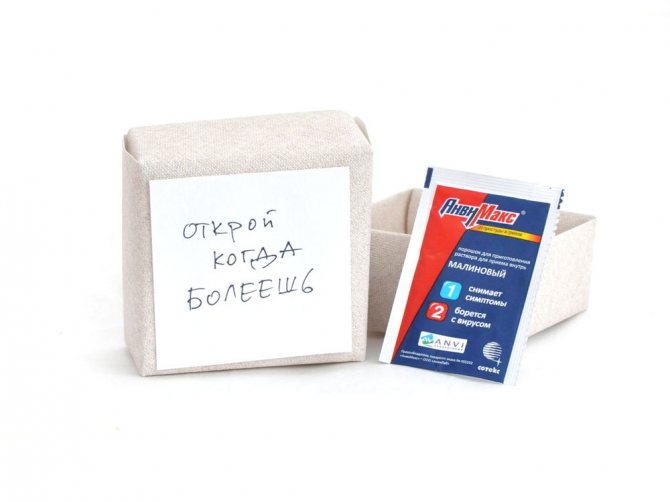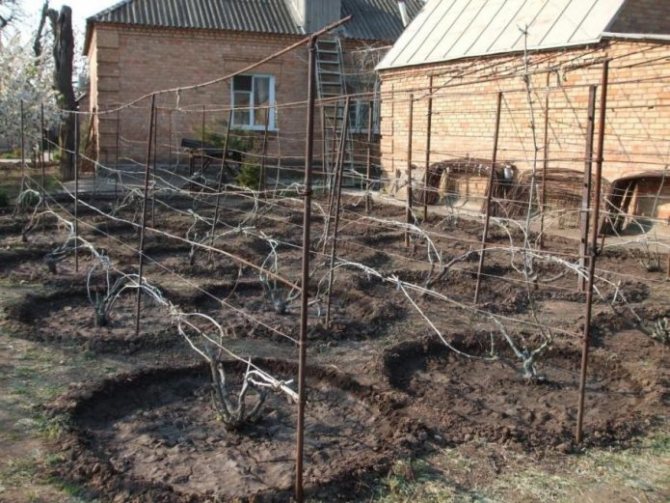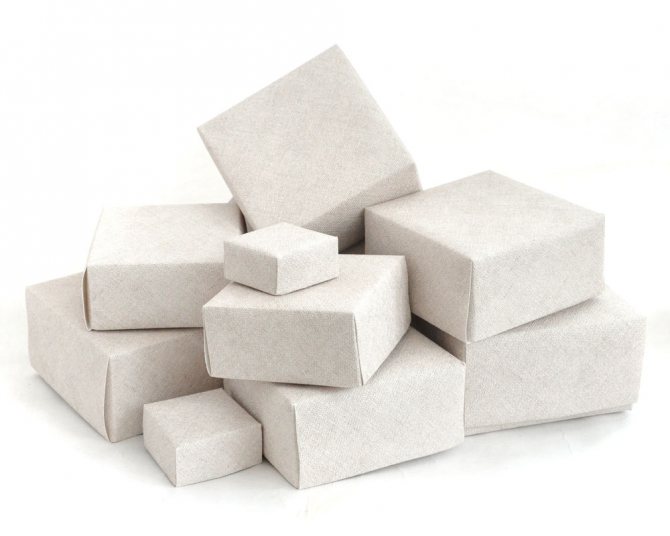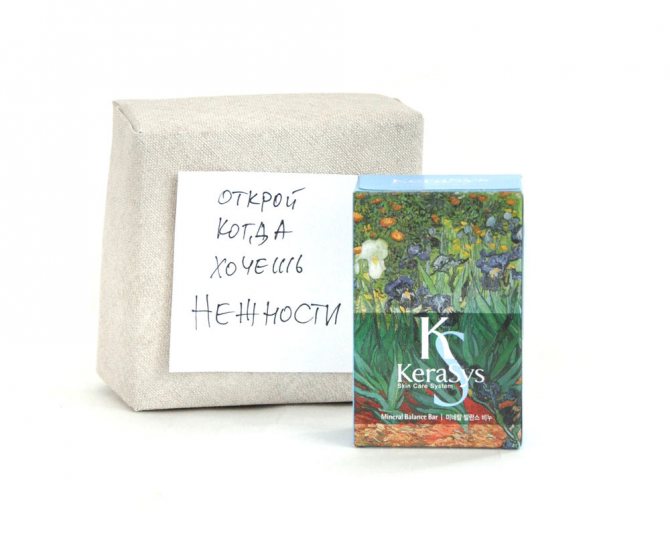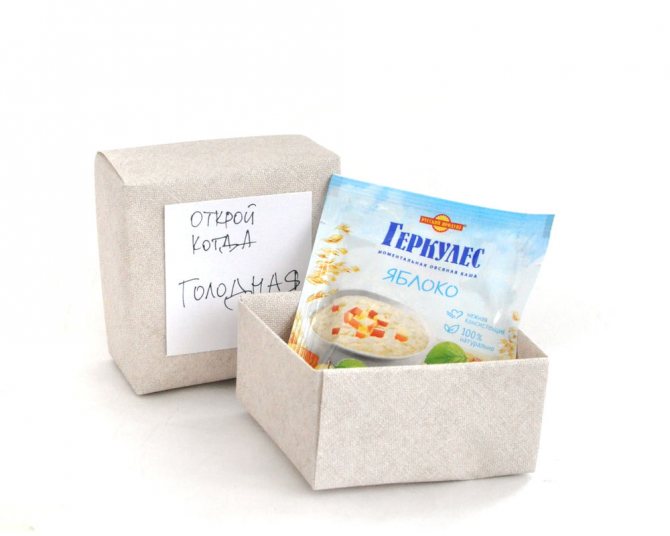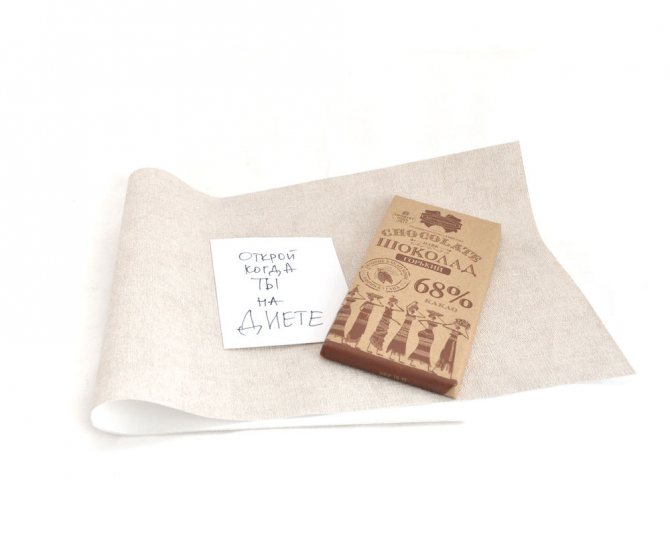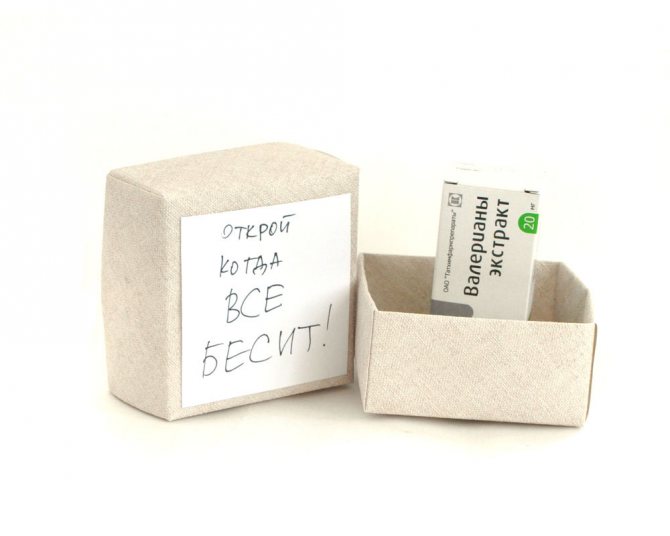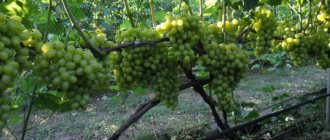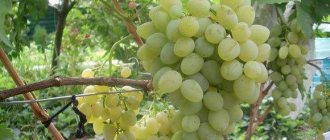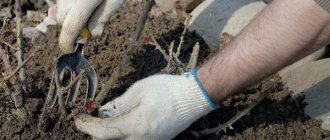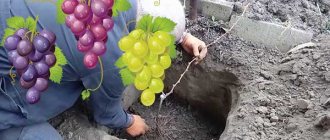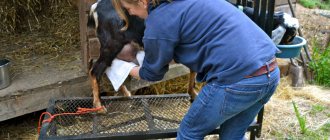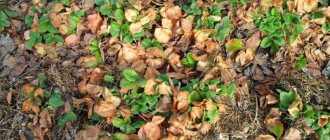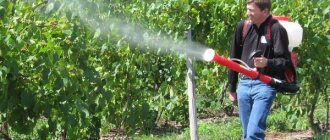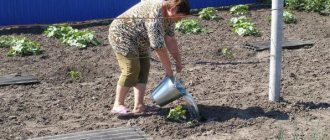Fruits and berries »Grapes
0
631
Article rating
It is necessary to open grapes after wintering at a certain temperature regime. If the procedure is carried out too early, there is a risk of losing the vine from frostbite. If you overexpose the cover, the vine will rot - the plant will suffocate.
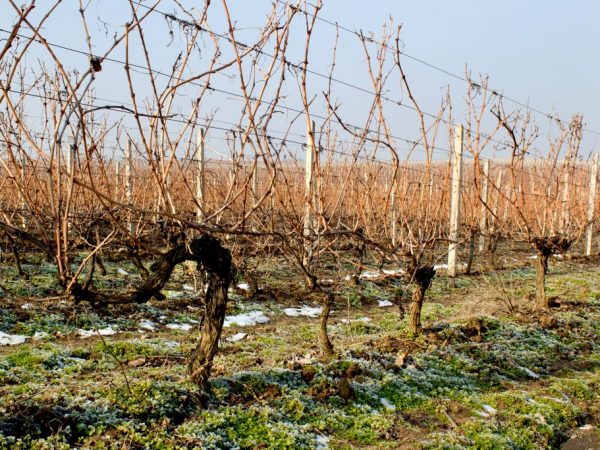
When and how to open grapes after winter
At what temperature can grapes be opened
The first thing a gardener should pay attention to is the weather conditions. It is important to know not only at what temperature to open the grapes, but also to take into account the fluctuations in these readings during the day and night. Despite the fact that grapes are a thermophilic plant, under cover, many varieties can withstand temperatures down to –20 ° C quite well.
When the grapes are open, the culture without consequences can tolerate frosts down to -5 ° С... However, the greatest damage to the plant is caused not by low temperatures, but by their sharp drops. Therefore, before starting work, you should study the weather forecast at least a week in advance.
So when to start shooting grape cover? To do this, the following temperature requirements must be met:
- daytime temperature should be above + 5 ° C;
- at night thermometer readings should not fall below -5 ° C.
In other words, the first manipulations to free the culture from covering materials should be carried out even when there is still snow. At this time, signs of awakening begin to appear on some trees - the buds swell.
Spring frost protection
A strong vine with dormant buds can withstand frosts down to -4 ° C, with open buds it easily dies at a temperature of -1 ° C.
- In northern regions with an unstable climate, it is customary to remove winter shelter material and replace it with more ventilated material. This is done as follows: an arch is installed over the bushes, which is covered with non-woven material to protect the plants from night frosts.
- In this case, you should not use a film: it creates a greenhouse effect. The buds and eyes can become rotten, in the future there is a risk of fungus and mold appearing on the bush. It is better to use materials like spunbond and agrotex. They let in fresh air, but at the same time keep warm. Such a shelter is able to protect the bushes from frost down to -3 ° C. If lower temperatures are expected, it is better to use winter insulation.
- Another way that allows you to raise the temperature by 3 ° C-4 ° C is fuming. The weather at this time should be calm, the smoke should travel between the bushes, and not go up. Then it will reduce the intensity of heat release from the soil.
When to open grapes
There is no specific time frame for when grapes should be opened after winter. It all depends on the climate of the region and the ambient temperature. The indicator of the amount of precipitation is also important. If in spring it often rains or rains with snow, and at night the temperature is still below freezing, then it is better to postpone the work until a little later.
With heavy precipitation, the soil is saturated with moisture, which lingers for a long time in the area of the root system. If you open the culture ahead of time, then the low temperature can lead to freezing of the roots, which often leads to the death of the plant.Late opening can also reduce yields as leads to:
- decay of the kidneys;
- the development of diseases;
- improper bush formation;
- breaking off the vine.
The vine and buds, which are under the covering material for a long time, do not receive enough sunlight, as a result of which the process of photosynthesis does not occur, and the chlorophyll pigment is not produced.
After opening, these shoots have a faint, pale appearance. They are also called leaded - grown without access to light. They are extremely sensitive to ultraviolet rays and, with a sharp opening, such a vine can get sunburn, which, with a certain degree of probability, will lead to the death of the shoot. Therefore, here you need to find a middle ground. Below we offer average terms depending on the region.
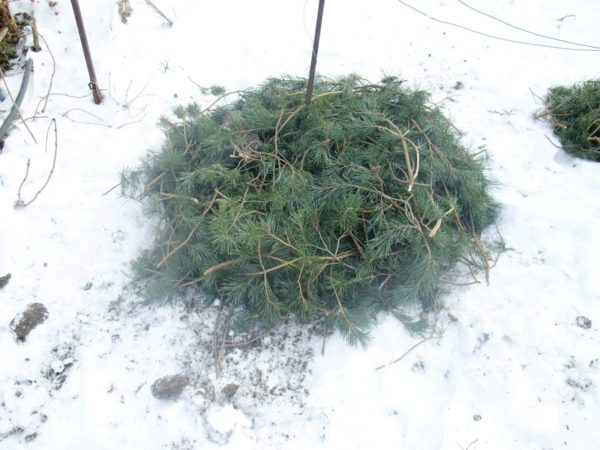

In Siberia
Only the experience of local gardeners will help to more accurately determine the start date of work in a particular region. This is especially true of risky farming zones, which include the Siberian region. Experience shows that in Siberia, for example, in:
- Novosibirsk;
- Tomsk;
- Omsk;
- Altai Territory.
Depending on weather conditions, work can be done from late April to mid-May... And with late snowmelt or high humidity, they can be transferred to early June.
When to open a plant in spring
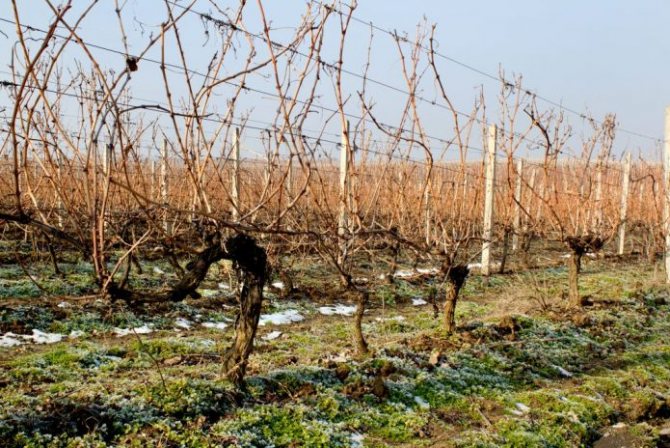

It is recommended to open the vine under the following conditions:
- complete melting of snow on the site;
- the disappearance of puddles and drying of the upper soil layer;
- establishment of a stable average daily temperature from -5 ° C to 0 ° C.
It is not advisable to keep grapes under winter protection for too long, but too early release is also not encouraged. In both cases, the outcome is the same - the loss of the crop or the plants themselves. This is due to the death of the ovaries under the film from the sun and night frosts. If we focus on weather conditions in terms of the territorial factor, then the timing of the disclosure of culture is as follows:
- the middle zone of Russia, the Moscow region and the Volga region - mid-April (with early spring warming) and the end of May (in the case of late spring);
- southern regions - from March 20 to the end of April;
- Far East, Ural, North - at the beginning of May, but with the construction of a greenhouse protection (in case of a sudden cold snap at night).
How to open grapes correctly
There are several ways to shelter grapes for the winter (we already wrote about them here). This can be as simple hilling as full cover. Regardless, grapes should be opened gradually. To make all the necessary manipulations on time and not lose the harvest, you must follow certain rules:
- work should be carried out in the daytime when the temperature reaches at least + 5 ° C and there is no risk of frost at night;
- if the grapes are insulated by the simple hilling method, then the disclosure begins with loosening the snow cover around the bush. When the temperature at night stops dropping below -2 ° C, the snow cover is removed completely and replaced with a small amount of hay or straw;
- with partial or complete cover of the grapes, the snow cover is also removed first. In the daytime, protective structures are partially or completely removed in order to begin to ventilate the soil, but at night they are collected back.
Care
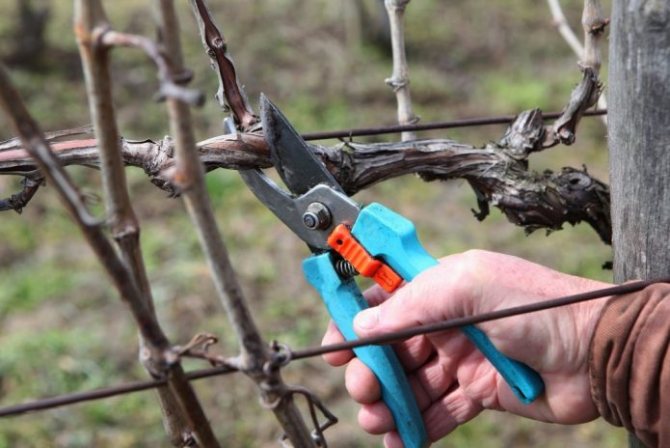

Caring for a grape crop after winter is a long and staged process. This plant is finicky and needs caring. Therefore, agrotechnical measures must be carried out in compliance with certain rules.
Main steps:
- Pruning. This procedure is started after examining the vine. It is important to cut off all old branches, which usually account for up to 70% of the total volume of the bush. Leave some young shoots on the sleeve and at the base, but so that they do not interfere with each other's growth. For work, use a sharp garden tool, preferably a pruner.Then the procedure does not severely injure the plant.
- Treatment. It means spraying the bushes with chemical preparations ("Baikal EM-1", "Guapsin", "Biosporin"), or biological (Bordeaux liquid, "Karbofos", "Nitrofen") type. This is necessary to protect against pests and diseases.
- Top dressing. Before removing the covering material, fertilize the soil by watering with a special solution. For this, superphosphate (20–25 g), potassium salt (5–7 g) and ammonium nitrate (10–12 g) are diluted in a ten-liter bucket with water. This volume is enough for one bush. It is recommended to fertilize during the daytime. With the appearance of the first leaves, they are treated with fungicides (for example, nitrophen). To prepare the solution, you will need 200 grams of the product and 10 liters of water.
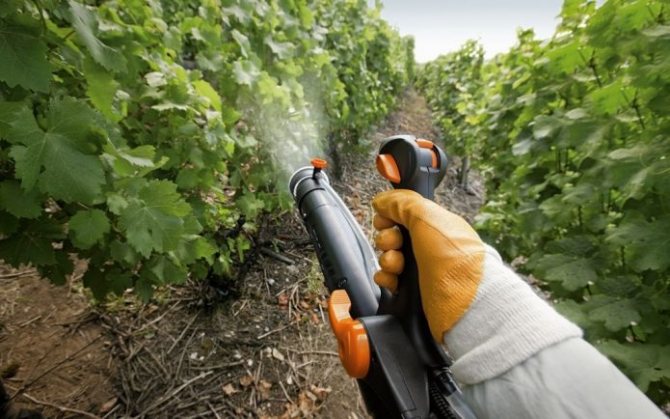

- Watering. In the spring, there is no particular need for moisture, since there is plenty of moisture in the soil. Water only in steady hot weather and no more than once every 10 days. Water is pre-defended and poured into drainage ditches or specially dug holes nearby.
- Loosening. Loosening and removal of weeds are started even before the winter shelter is removed from the grapes. Repeat the procedure as soon as the earth is completely dry and warmed up. In the future, this procedure is resorted to at least 5-6 times during the growing season. To preserve moisture and inhibit the growth of weeds, the root zone is covered with a layer of organic mulch.
Caring for vine plantations is a laborious and painstaking process. This requires experience, which is accumulated gradually. And at first, you have to face a number of difficulties that can be easily eliminated if you listen to professional recommendations. This also applies to measures taken to grapes after wintering. Only a competent approach guarantees a good harvest.
What to do in case of frost
To save plants from sudden frosts, you can use the following methods:
- the first thing to do is to save the root system. This can be done using any covering material that is at hand: hay, straw, sawdust, etc.
- to save vines and partially opened buds, a quick-erect temporary greenhouse shelter is best of all.
Its frame can be made from any available materials: sticks, wire, reinforcement. On top of the frame, you need to throw any plastic wrap. Such a structure is quickly built and is quite capable of saving from short-term frosts.
Vine processing
Pruning is followed immediately by preventive spraying to eliminate the likelihood of disease and the formation of broods of parasites. To complete the procedure, you will have to acquire preparations of fungicidal and insecticidal effects, they are actively used:
- Nitrofen - the drug stimulates the development of the vine and eliminates harmful bacteria, insects;
- Karbofos - insecticidal substance, kills parasites;
- Oxyhom - the drug helps well against various types of ticks;
- A mixture of 800 g of urea, 200 g of copper and 250 g of ferrous sulfate. A positive result was noticed and a significant improvement in the health of the entire vine;
- Bordeaux liquid is an effective remedy against all kinds of fungi. The peculiarity of the drug is that it must be poured under the root.
Spring work after opening
After the plant is fully disclosed, and the threat of frost is over, it is necessary to start preventive work aimed at increasing yields and protecting the grapes from diseases.
Garter
The garter is made immediately after the shoots have dried out a little. In this form, they are more flexible and brittle. The procedure is carried out for the correct formation of the bush and more convenient processing of the culture.
The first garter is made in late April - early May.The second time, the procedure must be repeated approximately in a month, when it becomes necessary to distribute new shoots along the trellises.
Pruning
After strapping, it is necessary to inspect all shoots and identify non-viable or unnecessary branches. To determine the frostbite and dried vine, it is necessary to make a test cut. If the core is brown or dark in color, then the shoot is dead.
Tillage
The soil around the bush is loosened with a hoe. It is done for better drying of the soil, destruction of weeds and preventing the development of fungal diseases.
Chemical treatment
The vine and soil around the bush, in order to avoid the development of molds and other diseases, should be treated with antifungal drugs. For this, Bordeaux liquid, copper sulfate, etc. are used. Preparations should be used according to the instructions for use. The first treatment is carried out even before the swelling of the kidneys.
Top dressing
An important stage in spring work is root fertilization. For this, nitrogen, phosphate and potash fertilizers are used in a ratio of 5: 4: 3. Fertilizers are applied immediately after the full disclosure of the plant. Of course, the procedure is not performed if it is necessary to inhibit growth.
When cultivating grapes, every stage of plant care is important. The quality of the harvest largely depends on the gardener's ability to correctly calculate the opening time of grapes in spring.
Spring garter of grapes
Do not tie up vines right after you have removed your winter shelter. Let the plant "recover" a little. Just spread the shoots, spread them on a trellis, and let them ventilate like this for three days. Spring garter of grapes is also called dry, as woody, not green shoots are tied.
Until you tied up the grapes, you can check how it overwintered. To do this, cut a small piece of the shoot with a pruner. The cut should have a healthy light green color. Also inspect the buds, move the scales apart under them there should be live green rudiments.
The grapes are traditionally tied to a trellis, which consists of two two-meter pillars dug in at a distance of three meters, between which a wire is stretched. The first wire is pulled at a height of 40 cm, the subsequent ones at the same distance from each other. Dry perennial sleeves need to be tied on the first tier with a fan. The rest of the shoots are fixed on the second wire at an angle of 45-60 degrees relative to the ground. It is very important that the shoots are not tied vertically. In this case, only the upper 2-3 buds will develop, and the rest will grow weakly or will not wake up at all. It is most convenient to tie up the shoots with any soft wire. Later, when the buds begin to grow, young green shoots are tied vertically to higher tiers.
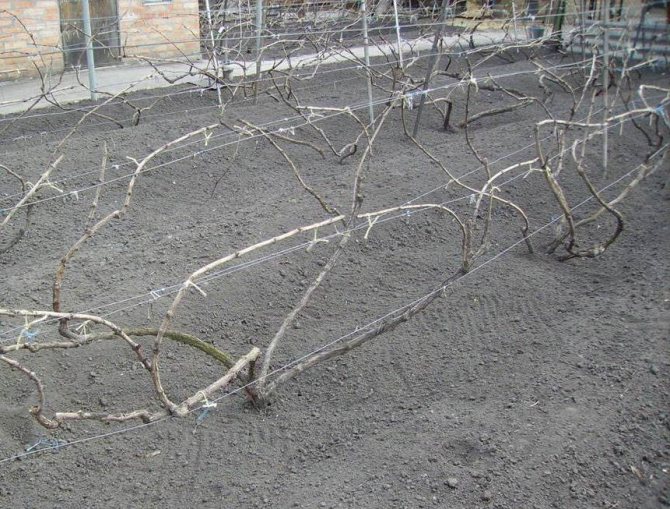

In the spring, the sleeves are tied to the first tier, and the shoots to the second
Video: spring garter of grapes
Conditions
The process of opening the bushes will largely depend on the way they were hidden and the region where the vineyard grows. In warm climates, everything is quite simple, the main thing is to avoid delays in the established warm weather, so that the buds do not grow right in the shelter. But in the case of cold and very cold regions, its own specificity of work.
If there is a possibility of frost that will come even in May, then you need to open the bush differently. First you need to make ventilation in the shelter so that the vine is still protected, but already gets used to the environmental conditions. Next comes the waiting process when green neoplasms begin to appear. After that, you need to make a complete extraction of the vine and the garter of the branches. Buds that appear in this way can produce a full harvest.
When starting work on opening bushes, it is important to make sure that there is no stagnation of water around them, which will negatively affect the development of the plant. To prevent such situations when planting the grapes themselves, it is important to place them on a hillock, and not in a lowland.
Rules for caring for roses in spring after winter
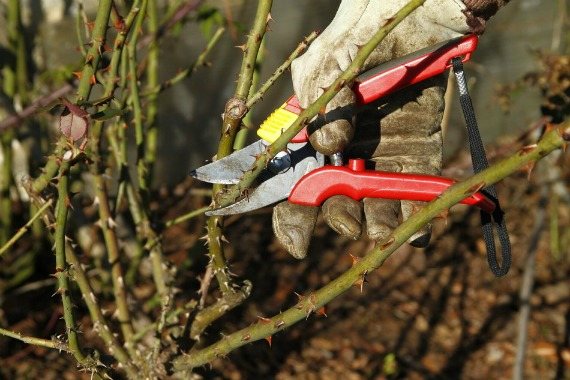

Pruning
The first spring trimming of bushes (around April) is called cosmetic and preventive at the same time. After winter, dry, frostbitten, broken shoots appeared, which are cut off completely or to the green part. After this crop trimming, it is recommended to shade before early or mid-May.
Formative pruning is carried out after two to three weeks and the requirements of each grade are taken into account. Most often, three shoots are left on young plants, and four to five shoots on adults. They should be strongest, strongest and evenly spaced.
Important! Pruning should be done before bud break.
- Hybrid tea varieties - remove one third of the shoot, cut off up to three to five buds.
- Grandiflora, Floribunda - cut to three to four buds.
- Climbing and semi-climbing - on young bushes, shoots are left at a height of ten to fifteen centimeters from the soil surface, the places of the cuts are sprinkled with ash or activated carbon powder.
- Ground cover species and varieties - pruning is carried out once every four years or five years. About fifteen to twenty centimeters on each shoot are subject to removal.
Watering mode
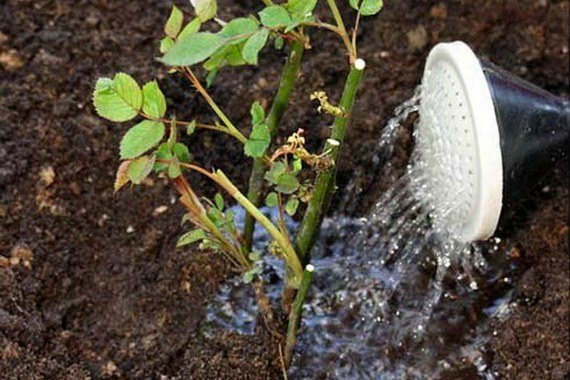

The frequency and volume of watering are set individually, taking into account the season, climate, weather, the rate of drying of the soil and the way it is moistened. For irrigation, you can use any water, but ideally - settled, rainwater and not necessarily cold.
In spring, during a period of high or moderate humidity and not yet overheated soil, roses need to be watered abundantly, but not often.
Excess moisture can lead to root rot or other diseases.
In the hot summer period, the soil needs to be moistened more intensively, but only in the early morning or late evening, when there is no direct sunlight. The soil surface near the bushes should not dry out too much.
Rose bushes respond positively to spraying, so it makes sense to install a system with a water spray near flowering crops. This will keep the soil moderately moist and reduce the amount of manual watering.
Top dressing
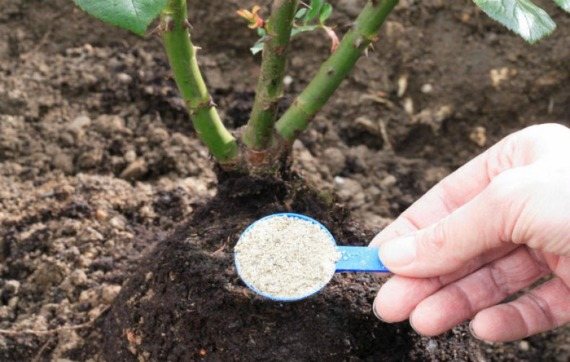

In spring, roses require additional nutrition containing magnesium, potassium, nitrogen, phosphorus. Top dressing can be mineral, organic or complex.
Thirty grams of the mixture (from equal parts of ammonium nitrate and ammonium sulfate) is added to the wet soil near the bushes for each square meter of the area, and the mixture is added to the irrigation water into the dry soil and applied at the root during irrigation.
As a liquid fertilizer under the root, you can take "Agricola", "Clean sheet for roses", and for sheet processing - "Terraflex".
It is possible to renew some of the soil under each bush, which will contribute to a healthier appearance and more abundant and lush flowering. Last year's soil under the plant (a layer about five to ten centimeters thick) is replaced with fresh compost or rotted humus.
Pest and disease control
In order for the fight to be more effective and destroy the maximum number of pests, it is necessary to withstand three to five warm and sunny days in a row, loosen the soil near the rose bushes and start with cultivating the land in the rose garden. Insects will want to bask in the sun, and it will be easier for them to get out of the loosened soil to the surface, where an unpleasant surprise will await them.
The first spraying is for the soil, the second (after a week) for the soil and plants.You can use various copper-containing preparations, as well as "Aktara" (from aphids, rose leafhoppers and sawflies), "Horus" (from gray mold and powdery mildew). Solutions are prepared strictly according to the instructions on the package.
Caring for roses after winter step by step - video
Why timing matters
Some budding grape breeders may erroneously believe that opening late will be the right decision. This, of course, will save the grapes from freezing, however, it can lead to a sharp decrease in the amount of the harvest. Therefore, it is important to calculate the timing correctly and open the plant on time.
On a note!
In some sources, grape growers note that the opening is the beginning of the entire growing season. Therefore, the volume of the harvest and the health of the entire bush directly depend on the correct actions of the owner.
The main danger is freezing. The buds die earlier than the shoots. Most varieties are able to continue the growth of the vine from the frozen formation, from the spare and side shoots. However, it is rare that a crop has been obtained from such branches. If a bush is frozen out due to an early opening, it most likely will not bear fruit at all, not only for one year, but also for the next one.
Late opening can lead to such consequences as:
- breaking off shoots;
- decay of the kidneys;
- the development of fungal diseases.
Condensation forms under the film, which is often used for shelter, when heated by the sun. In such an environment, mold and mildew develop rapidly. Not useful for grapes and the contrast between the temperature of cold soil and warm air already coming from the surface.
If the buds have managed not only to swell, but also to sprout, it will be very difficult to preserve them when opening and tying them. More than half usually die in the course of further work. The yield of each bush decreases by the same amount.
Early disclosure risk
Any grape variety is a heat-loving plant, therefore the presence of severe frosts is an uncomfortable environment for it. Every year, breeders try to breed winter-hardy varieties that can easily withstand cold temperatures down to -25 degrees, but they have not yet been able to deal with temperature fluctuations. It is the abrupt change in the weather that affects the vine, dooming the grower to the loss of the harvest, or even the entire bush.
Correctly and in a timely manner to open the bush after wintering is not an easy task, because for this you need to choose the optimal weather conditions. With warming and the first warm rays of the sun, the vine begins to bud, for which it is extremely important to develop under optimal conditions. If during this period there is a jump in temperature from plus to -5, then the young shoots will die.
It is also dangerous to overexpose the vine in a shelter when a stable heat begins on the street. As soon as the earth warms up enough, the buds will still begin to grow actively, and without the participation of the sun, they will not be able to develop normally and will die.
There are no absolutely exact established dates for the opening of grapes, because each region has its own climatic characteristics, and you need to focus exclusively on the weather. When the snow melts completely and the ground dries well, this will be the first sign that you can go to the vineyard. Temperature readings should be consistently high during the day and at least five degrees below zero at night.
It is advisable to plan the opening procedure itself on a clear and sunny day so that the vine has time to dry out, which minimizes the harm from the night coolness. If a significant cold snap is expected, it is better to cover the bushes at night, and open again during the day. If it is not possible to instantly respond to climate change, you should not rush to open it if the nights are still cold. When the thermometer readings are at a positive mark around the clock, you can fully open all the bushes and prepare for further work on caring for them.
Read more: Grapes ladies fingers variety description care features
How to keep roses from damping out
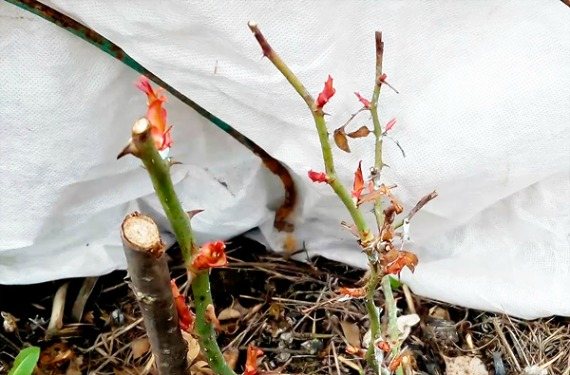

Preventive work should begin in the fall, when the plants are being prepared for wintering. Before the construction of a protective shelter, the bushes are treated with special preparations. For spraying, it is recommended to use solutions containing copper or based on ferrous sulfate with a small addition of liquid laundry soap.
The appearance of rot (or damping) also depends on the correct choice of covering material. It is necessary to use a shelter that will not interfere with the penetration of air, but will also protect from the cold, will not create conditions for the accumulation of moisture and will give the crops the opportunity to breathe fully.
If the requirements for the autumn processing of bushes and the choice of covering material are met, then now the most important thing is to remove the cover in time and gradually in spring, and also to carry out important additional measures.
- It is recommended to clean the place of grafting of the bush from the earth layer, and then rinse this area with a solution of copper sulfate.
- Separate areas with the appearance of signs of damping off are removed, and the remaining shoots are treated with a fungicide or copper sulfate.
- If the bush is severely damaged, it is necessary to carry out more serious processing. A solution based on "Kornevin" or "Kornerost" is introduced under the root, and "Epin" is used for spraying (five to six drops per one and a half to two liters of water). Plants should recover by the first half of June.
Answers to frequently asked questions
What if the roses are frozen?
Severely frozen areas are cut off and lubricated with garden varnish, the cuts, slightly frozen - treated with manganese (four liters of water and one gram of manganese) or iodine (half a liter of water - two to three drops of iodine) solution. Warm water with mineral fertilizer is introduced under the root, each bush is spud.
What if the roses turned black after winter?
The blackened shoots are cut to the green part, the cut is smeared with brilliant green. If the shoots are completely blackened, then they need to be cut off to the grafting sites. After pruning, such bushes need top dressing with a high nitrogen content or with ammonium nitrate.
After removing the shelter, foci of mold were found
It is recommended to treat foci of mold with a 1% solution of copper sulfate or a saturated manganese solution.
How to eliminate frost cracks in a rose after winter?
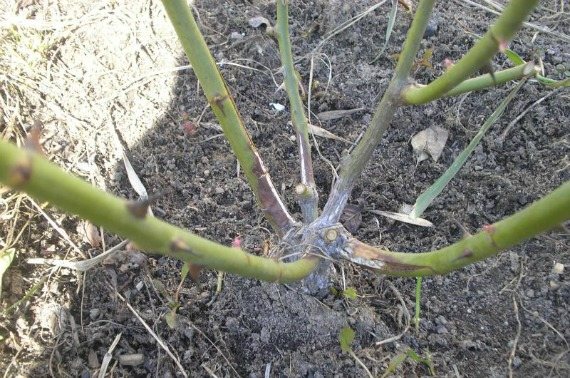

In the presence of large cracks, it is better to remove the shoot completely, and small and medium frost holes are washed with manganese solution or copper sulfate (ten grams per liter of water), and then a plantain leaf or aloe leaf cut along the length is applied and fixed with a plaster.
What if the roses don't want to "wake up"?
First, roses need to be watered abundantly with ordinary water with a temperature of about thirty to thirty-five degrees, and after a few hours a solution is poured under the root from one glass of water and ten drops of "Fitosporin" or any other root growth stimulator.
What if the winter shelter has already been removed and the frost returns?
To protect the rose garden, use any non-woven covering material, lutrasil or small cardboard boxes for each bush separately, with which the plants are protected only at night.

